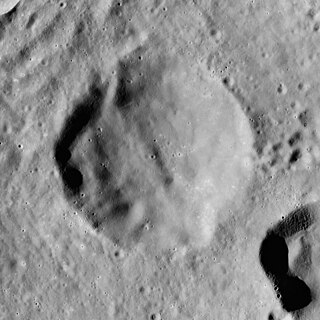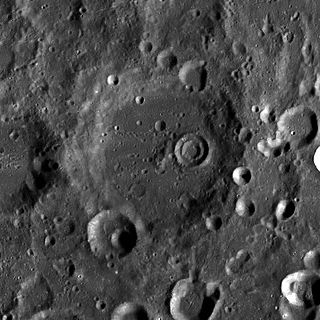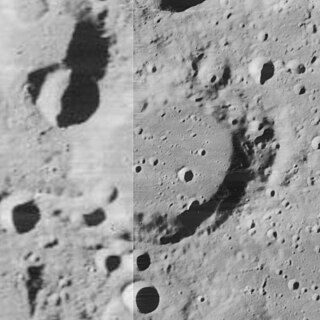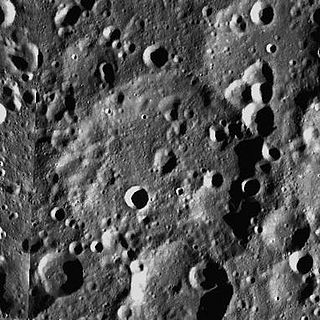
Bingham is a small lunar impact crater that is located on the far side of the Moon, relative to the Earth. It is named after the American academic, explorer and politician Hiram Bingham III. It lies just to the southeast of the much larger crater Lobachevskiy, and the northwestern part of the rim of Bingham is partly overlaid by ejecta from Lobachevsky. To the northeast of Bingham is the crater Guyot, and about a crater diameter to the south-southeast is Katchalsky. This is a roughly circular crater formation with a slight outward bulge along the southeastern side.

Daedalus is a prominent crater located near the center of the far side of the Moon. The inner wall is terraced, and there is a cluster of central peaks on the relatively flat floor. Because of its location, it has been proposed as the site of a future giant radio telescope, which would be scooped out of the crater itself, much like the Arecibo radio telescope, but on a vastly larger scale.

Alhazen is a lunar impact crater that lies near the eastern limb of the Moon's near side. Just to the south-southeast is the crater Hansen, and to the west is the Mare Crisium. The rim of Alhazen is nearly circular, but appears highly oblong when viewed from the Earth due to foreshortening. The inner walls and the crater floor are rugged and irregular. A low ridge joins the south rim of Alhazen with the nearby Hansen. The crater is named after the Arab Muslim scientist, Ibn al-Haytham.

Barocius is an ancient lunar impact crater that is located in the rugged southern highlands of the Moon. It was named after Italian mathematician Francesco Barozzi. It lies just to the southeast of the large crater Maurolycus. To the southwest of Barocius is Clairaut, and to the south-southeast lies Breislak.

Burckhardt is a lunar impact crater that is located in the northeast part of the Moon. It lies between the craters Geminus just to the north and Cleomedes to the south.

Balboa is a lunar impact crater that is located near the western limb of the Moon. Due to foreshortening, the crater appears highly oval when viewed from the Earth. In actuality, however, the formation is relatively circular. It is comparable in size to the crater Dalton, located just to the southwest. The eastern rim of Balboa lies just to the west of the Oceanus Procellarum.

Brianchon is a lunar impact crater that is located along the northwestern limb of the Moon. Due to its location, from the Earth the crater is seen from the edge and its visibility is somewhat affected by libration. Thus for a more detailed view, the crater must be viewed from orbit.

Bell is a lunar impact crater that is located on the far side of the Moon, just past the western limb. It lies in an area of terrain that is marked by many small craters, a number of which are satellite craters of Bell listed in the table below. Bell lies within two crater diameters of Laue to the north, and to the west of the smaller Helberg.

Ellison is a lunar impact crater that lies on the far side of the Moon from the Earth. It is located just beyond the northwest limb of the Moon, to the southwest of the large walled plain Poczobutt. Due west of Ellison is the crater Coulomb.

Cysatus is a lunar impact crater that is located in the southern part of the Moon's near side. It is joined to the northeastern rim of the larger crater Gruemberger, and intrudes slightly into the interior of that formation. Due south is the larger Moretus, and to the east is Curtius. These craters appear foreshortened when observed from Earth because of their far south location.

Cleostratus is a lunar impact crater near the northwest limb of the Moon. It lies to the northeast of the crater Xenophanes, and west-southwest of the prominent Pythagoras. From the Earth this crater appears highly elongated due to foreshortening.

Chapman is a lunar impact crater that lies just beyond the northwest rim of the Moon, on the far side as seen from the Earth. It lies to the northeast of the crater Rynin, and southward of the large walled plain Poczobutt.

Debye is a lunar impact crater that is located in the northern hemisphere on the Moon's far side, as seen from the Earth. It lies to the south of the crater Chappell, to the southwest of the walled plain Rowland, and to the east of D'Alembert.

Comrie is a lunar impact crater. It is located on the rugged far side of the Moon relative to the Earth, beyond the western limb. Nearby craters of note include Ohm to the south-southwest, Shternberg to the southwest, and Parenago to the northeast.

Fourier is a lunar impact crater that is located in the southwestern part of the Moon's near side, just to the southeast of the crater Vieta. To the northeast is the Mare Humorum. The rim of this crater is roughly circular, but appears oval when viewed from the Earth due to foreshortening.

Fraunhofer is a lunar impact crater that is located just to the south-southwest of the walled plain Furnerius, in the southeastern part of the Moon. This crater appears foreshortened when viewed from the Earth, and is actually nearly circular.

Dante is a lunar impact crater that is located on the far side of the Moon. It lies in the northern hemisphere exactly opposite the prime meridian facing the Earth. The nearest craters of note are Larmor to the north and Morse to the southeast. To the southwest is the oddly shaped Buys-Ballot.

De Vries is a lunar impact crater on the far side of the Moon relative to the Earth. It lies about midway between the craters Racah to the north-northwest and Orlov to the south-southeast. An nameless walled plain lies between De Vries and Orlov, with the perimeter of this feature joining the two rims.

Idelʹson is a lunar impact crater that is located on the far side of the Moon. It lies just behind the southern lunar limb, in a region that is sometimes brought into view of the Earth due to libration. Idel'son is situated to the southwest of the huge walled plain Schrödinger.

McLaughlin is a lunar impact crater that is located just behind the northwestern rim on the far side of the Moon. This portion of the surface is sometimes brought into view of the Earth due to libration, and the area can then be viewed from a low angle under favorable lighting conditions. McLaughlin lies to the west-southwest of the crater Galvani. About two crater diameters due west lies Rynin.




















